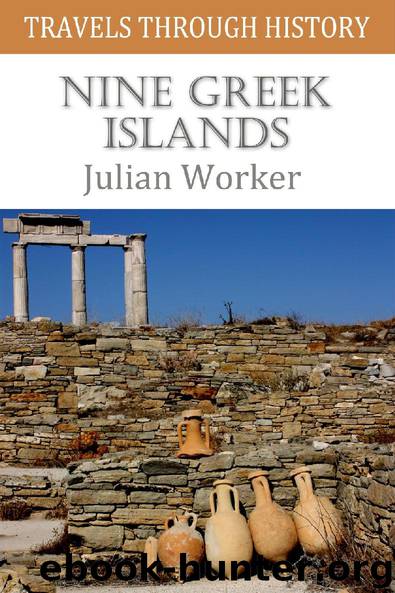Travels through History: Nine Greek Islands by Julian Worker

Author:Julian Worker
Language: eng
Format: epub
Tags: Panagia Ekatontapiliani church, Paros, Greece, Greek Islands, Aegean islands, archaeological, museum, places to go, places to see, churches, cathedrals, towns, cities, city, ancient, sights, sites, photos, photos of, images of, tourist, destinations, tourist sights, tourist sites, why go to, what is there to see, traveller, traveler, tourism, what not to miss
ISBN: 9781785389023
Publisher: Andrews UK Limited 2018
Published: 2018-04-24T00:00:00+00:00
Syros - Cyclades
Syros - Umbrellas over a street in Ermoupoli
The first historical mention of Syros is made by Homer, who named the island as “Syria” and then referred to it as “dipolis”, meaning it had two cities: Posidonia and Foinikas. The first known inhabitants were the Phoenicians during the second millennium BCE followed by the Minoans, Mycenaeans, and finally, in the early part of the first millennium BCE, the Ionians.
Ancient Ermoupolis was built by the Ionians, who then gave way to Persians, Romans, Franks and Turks. The people who left the biggest impression on the city were the Venetians, who made Syros an important commercial centre of the Eastern Mediterranean. Repeated raids by pirates forced the residents to relocate the capital up the hill to Ano Syros. Presumably the residents thought the pirates were either unfit or just plain lazy. When the island was conquered by the French, Capuchins monks settled in Syros in 1635 and founded a small monastery, still open to this day. In 1744, Jesuit monks arrived on the island.
At the beginning of the Greek War of Independence in 1821, the island’s population was about 4,000, mainly in the settlement of Ano Syros. After the massacre of Chios in 1822 and the persecution of Greeks on Samos, Rhodes, and in Smyrna, amongst many others, there was a large wave of refugees to Syros. Refugees found Syros to be a relatively safe place and started to build a vibrant city with impressive buildings at the foot of the hills below Ano Syros. In 1828 there were 14,000 inhabitants in Ermoupolis. This figure reached 20,000 inhabitants in 1850 and 22,000 in 1899.
Arriving at Ermoupolis, now the capital of The Cyclades Islands and known as “The Queen of the Aegean”, I couldn’t help but be impressed by the loveliness of this town that stretched up the hillsides towards the blue sky. Ermoupolis was the busiest port in the whole of Greece and a centre for shipbuilding. The wealth generated by all this commerce manifests itself in the stateliness of the mansions all around and in the number of large churches.
My hotel was the former home of the architect Georgios Vitalis and was located about a third of the way up the Vrondadho hill, just behind the Orthodox Cathedral or Mitropolis. In Syros, the orthodox population tends to live in the lower part of Ermoupolis whereas the Catholics live in the upper town and in the villages of the island.
The Plateia Miaouli is the centre of the town, a large open square, surrounded on three sides by palm trees, cafes, and benches for people watching. This is the square where the local population goes to be seen. It’s dominated by the glorious, neoclassical town hall, designed by Ernst Ziller. The square and accompanying statue are named after the Hydriot naval hero Andreas Vokos, whose nickname was Miaoulis. He commanded Greek naval forces during the Greek War of Independence between 1821 and 1829.
Download
This site does not store any files on its server. We only index and link to content provided by other sites. Please contact the content providers to delete copyright contents if any and email us, we'll remove relevant links or contents immediately.
Full Circle by Michael Palin(3271)
How to Read Water: Clues and Patterns from Puddles to the Sea (Natural Navigation) by Tristan Gooley(3242)
Into Thin Air by Jon Krakauer(3132)
How to Read Nature by Tristan Gooley(3083)
In Patagonia by Bruce Chatwin(2758)
The Lost Art of Reading Nature's Signs by Tristan Gooley(2549)
A Thousand Splendid Suns by Khaled Hosseini(2524)
Don't Sleep, There Are Snakes by Daniel L. Everett(2500)
City of Djinns: a year in Delhi by William Dalrymple(2436)
Venice by Jan Morris(2436)
The Songlines by Bruce Chatwin(2414)
L'Appart by David Lebovitz(2397)
The Queen of Nothing by Holly Black(2324)
The Big Twitch by Sean Dooley(2320)
Tokyo Geek's Guide: Manga, Anime, Gaming, Cosplay, Toys, Idols & More - The Ultimate Guide to Japan's Otaku Culture by Simone Gianni(2243)
A TIME OF GIFTS by Patrick Leigh Fermor(2103)
Iranian Rappers And Persian Porn by Maslin Jamie(2101)
INTO THE WILD by Jon Krakauer(2086)
Come, Tell Me How You Live by Mallowan Agatha Christie(2030)
